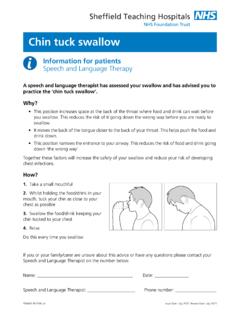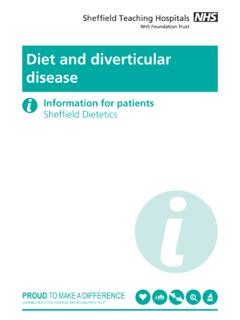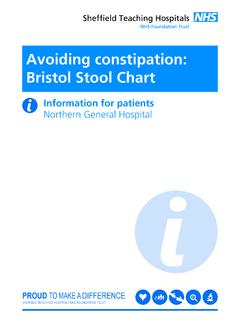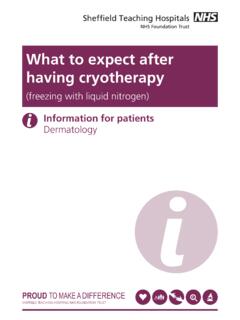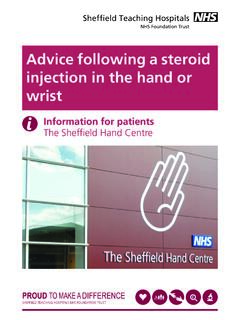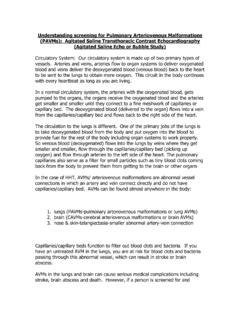Transcription of Stroke: Upper limb exercises
1 PROUD TO MAKE A DIFFERENCESHEFFIELD TEACHING HOSPITALS NHS FOUNDATION TRUSTS troke: Upper limb exercisesInformation for patientsTherapy Servicespage 2 of 8 Stiffness and stretchesAfter a stroke you may have difficulty moving your arm. If you just leave it, this will make the muscles and joints of the arm stiff and way to stop this happening is to stretch the muscles. This can be either by leaving it in a comfortable position that stretches your arm, or by doing some gentle movement exercises . This can be done by using your other arm to assist, or by getting someone to help should be done at least 3-4 times a day, for at least 5 minutes each time (in total for about half an hour a day). Try to add them into your normal routine, or get into the habit of doing a few exercises in the odd moment throughout the day. Ask your family or friends to remind you if you forget. Remember the shoulder is a delicate joint and these exercises should always be comfortable and never cause pain.
2 Please see the next few pages for some gentle movement exercises ; try to repeat each exercise 10 times. These should be completed slowly and gently giving the arm as much support as possible. Ask your Physiotherapist or Occupational Therapists if you have any questions or you want them to check that you are doing them correctly. page 3 of 8 exercise 1 - Taking arm out to the sideThe arm will often pull across the body and turn inwards so that your armpit gets tight. To help prevent this, hold the elbow and forearm and gently lift the elbow up so the arm comes away from the body. Be very careful as the shoulder is a vulnerable joint that can become very loose or painful. Do not lift the arm above shoulder height. exercise 2 - Moving arm forwards and backwardsContinue to support the elbow and forearm, but now take the arm forwards and backwards, leading from the elbow and shoulder. Do not lift the arm above shoulder height. exercise 3 - Rotating arm away from bodyKeep the arm bent to 90 degrees and the elbow close to the side of the body throughout the the wrist away from the body so it is rotating outwards.
3 This can be tight so be very careful. page 4 of 8 exercise 4 - Elbow flexion and extension Bend and straighten the arm as far as it will comfortably go. Ensure the arm is well supported at the elbow and avoid any pulling or traction at the shoulder joint. exercise 5 - Turning palm up and downKeeping the arm bent to 90 degrees, supporting at the elbow turn the forearm palm up and then palm down. Try to hold a short stretch at the end of each movement. page 5 of 8 exercise 6 - Wrist up and downSupport the wrist and bend it up and down. The most important way to stretch is going up, see picture above on the left. Be very careful as the wrist is another vulnerable joint that can become very loose or 7 - Moving fingersThe fingers get very stiff very quickly when they are not moved. To help prevent this, bend and straighten the fingers regularly during the day whilst supporting the wrist. Try to move them at the little joints in each finger. page 6 of 8 exercise 8 - Moving thumbThe thumb is very important to the function of the hand and it may get stiff across the palm, or in the web space.
4 To help prevent this, stretch the thumb away from the palm and the other fingers. You can practice moving the thumb to touch the tip of all the fingers, this is called opposition. Balancing activity and rest after you leave hospitalAfter any period of immobility due to injury, illness or an operation, your exercise tolerance will be lower and you will be more at risk of circulatory problems. Try to remain as active and mobile as you can after you leave hospital; this helps to maintain good circulation and joint and muscle health. Take adequate periods of rest through the day to aid recovery. Try to do shorter periods of activity more often, rather than too much in one go. Progress your activity levels gradually as your recovery 7 of 8 Individual comments: PD7949-PIL3322 v4 Issue Date: April 2021. Review Date: April 2024 If you have any questions or concerns please contact the physiotherapy department on 0114 271 3635. This leaflet is based on an original from Cambridge University Hospitals and has been reproduced with their formats can be available on email: Sheffield Teaching Hospitals NHS Foundation Trust 2021Re-use of all or any part of this document is governed by copyright and the Re-use of Public Sector Information Regulations 2005 SI 2005 Information on re-use can be obtained from the Information Governance Department, Sheffield Teaching Hospitals.
5 Email
